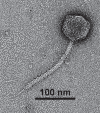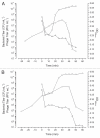Naturally resident and exogenously applied T4-like and T5-like bacteriophages can reduce Escherichia coli O157:H7 levels in sheep guts
- PMID: 21687531
- PMCID: PMC3109454
- DOI: 10.4161/bact.1.1.14175
Naturally resident and exogenously applied T4-like and T5-like bacteriophages can reduce Escherichia coli O157:H7 levels in sheep guts
Abstract
In preparing sheep for an in vivo Escherichia coli O157:H7 eradication trial, we found that 20/39 members of a single flock were naturally colonized by O157:H7-infecting phages. Characterization showed these were all one phage type (subsequently named CEV2) infecting 15/16 O157:H7, 7/72 ECOR and common lab strains. Further characterization by PFGE (genome∼120 kb), restriction enzyme digest (DNA appears unmodified), receptor studies (FhuA but not TonB is required for infection) and sequencing (>95% nucleotide identity) showed it is a close relative of the classically studied coliphage T5. Unlike T5, CEV2 infects O157:H7 in vitro, both aerobically and anaerobically, rapidly adsorbing and killing, but resistant mutants regrew within 24 h. When used together with T4-like CEV1 (MOI ∼2 per phage), bacterial killing was longer lasting. CEV2 did not reproduce when co-infecting the same cell as CEV1, presumably succumbing to CEV1's ability to shut off transcription of cytosine-containing DNA. In vivo sheep trials to remove resident O157:H7 showed that a cocktail of CEV2 and CEV1 (∼10(11) total PFU) applied once orally was more effective (>99.9% reduction) than CEV1 alone (∼99%) compared to the untreated phage-free control. Those sheep naturally carrying CEV2, receiving no additional phage treatment, had the lowest O157:H7 levels (∼99.99% reduction). These data suggest that phage cocktails are more effective than individual phage in removing O157:H7 that have taken residence if the phage work in concert with one another and that naturally resident O157:H7-infecting phages may prevent O157:H7 gut colonization and be one explanation for the transient O157:H7 colonization in ruminants.
Figures





Similar articles
-
Isolation and characterization of a new T-even bacteriophage, CEV1, and determination of its potential to reduce Escherichia coli O157:H7 levels in sheep.Appl Environ Microbiol. 2006 Sep;72(9):6405-10. doi: 10.1128/AEM.03011-05. Appl Environ Microbiol. 2006. PMID: 16957272 Free PMC article.
-
Application of bacteriophages to control intestinal Escherichia coli O157:H7 levels in ruminants.Appl Environ Microbiol. 2006 Aug;72(8):5359-66. doi: 10.1128/AEM.00099-06. Appl Environ Microbiol. 2006. PMID: 16885287 Free PMC article.
-
Genomic, proteomic and physiological characterization of a T5-like bacteriophage for control of Shiga toxin-producing Escherichia coli O157:H7.PLoS One. 2012;7(4):e34585. doi: 10.1371/journal.pone.0034585. Epub 2012 Apr 13. PLoS One. 2012. PMID: 22514640 Free PMC article.
-
Use of Bacteriophages to Control Escherichia coli O157:H7 in Domestic Ruminants, Meat Products, and Fruits and Vegetables.Foodborne Pathog Dis. 2017 Sep;14(9):483-493. doi: 10.1089/fpd.2016.2266. Epub 2017 Jun 21. Foodborne Pathog Dis. 2017. PMID: 28636835 Review.
-
Safety Properties of Escherichia coli O157:H7 Specific Bacteriophages: Recent Advances for Food Safety.Foods. 2023 Oct 31;12(21):3989. doi: 10.3390/foods12213989. Foods. 2023. PMID: 37959107 Free PMC article. Review.
Cited by
-
Characterization of a ViI-like phage specific to Escherichia coli O157:H7.Virol J. 2011 Sep 7;8:430. doi: 10.1186/1743-422X-8-430. Virol J. 2011. PMID: 21899740 Free PMC article.
-
Characterization and comparative genomic analysis of a novel bacteriophage, SFP10, simultaneously inhibiting both Salmonella enterica and Escherichia coli O157:H7.Appl Environ Microbiol. 2012 Jan;78(1):58-69. doi: 10.1128/AEM.06231-11. Epub 2011 Oct 21. Appl Environ Microbiol. 2012. PMID: 22020516 Free PMC article.
-
Tradeoffs in bacteriophage life histories.Bacteriophage. 2014 Jan 1;4(1):e28365. doi: 10.4161/bact.28365. Epub 2014 Feb 27. Bacteriophage. 2014. PMID: 24616839 Free PMC article.
-
The interactions of bacteriophage Ace and Shiga toxin-producing Escherichia coli during biocontrol.FEMS Microbiol Ecol. 2021 Aug 3;97(8):fiab105. doi: 10.1093/femsec/fiab105. FEMS Microbiol Ecol. 2021. PMID: 34329454 Free PMC article.
-
Phages in Food Industry Biocontrol and Bioremediation.Antibiotics (Basel). 2021 Jun 28;10(7):786. doi: 10.3390/antibiotics10070786. Antibiotics (Basel). 2021. PMID: 34203362 Free PMC article. Review.
References
-
- Brabban AD, Nelson DA, Kutter E, Edrington TS, Callaway TR. Approaches to controlling Escherichia coli O157:H7, a food-borne pathogen and an emerging environmental hazard. Environmental Practice. 2004;6:208–229. doi: 10.1017/S1466046604000365. - DOI
-
- Centers for Disease Control and Prevention (CDC), author Ongoing multistate outbreak of Escherichia coli serotype O157:H7 infections associated with consumption of fresh spinach—United States, September 2006. MMWR Morb Mortal Wkly Rep. 2006;55:1045–1046. - PubMed
Grants and funding
LinkOut - more resources
Full Text Sources
Other Literature Sources
Molecular Biology Databases
Miscellaneous
